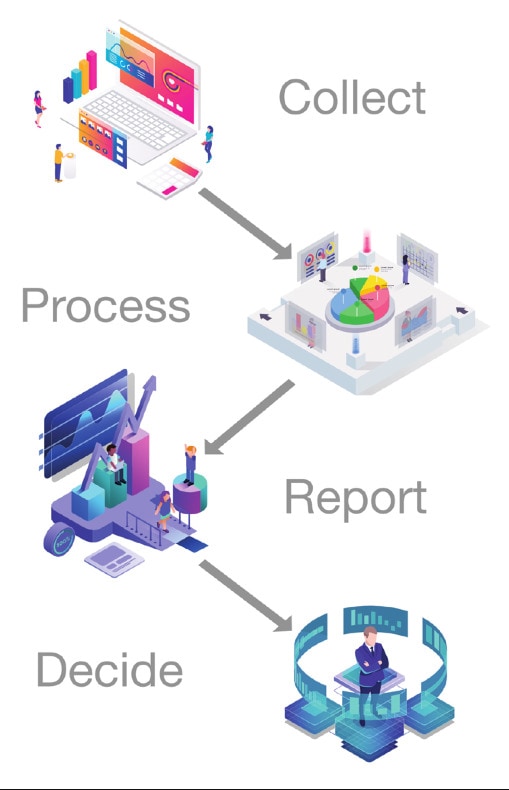The Aim
Workflow and Process Orchestration tools aim to improve efficiency in companies by increasing the speed of task completion and lowering expenses. It targets efficiency around information processing. This allows for better decision making and satisfies auditors and regulators by providing a full audit trail. It achieves this by capturing business rules on a platform that can use them to automate repetitive manual tasks, generate audit trails and give an overview of the entire process.
Integrated compliance processes in combination with an automated workflow framework will give continous insight into the impact of regulations on every aspect of the insurer’s operations.
The Challenge
Traditional workflow management was all about delivering the right piece of work to the right person to execute the task. Advancements in technology have extended workflow tools to be able to automatically execute repetitive manual tasks. However, to do so, it needs access to the right information. Many corporations have been unable to utilise this new technology as the required information is scattered amongst a multitude of different IT systems.

Corporations are hesitant to move to a single holistic system because they already have invested significant amounts in current systems and because the concentration risk is too high if all their IT operations are reliant on a single service provider. The different IT systems struggle to talk to each other; they are like pieces of a jigsaw puzzle that don’t quite fit. Thus if a corporation wants to connect all its information and get an overall view of the processes, to enable sound decision making and the automation of repetitive tasks, it will need a platform that brings all these systems together.
Read more about legacy systems, technology, and software.
The Solution
An Actuartech solution will be to provide a platform that brings together legacy systems, Robotic Process Automation, Natural Language Generators, Artificial Intelligence, etc. to give a coherent and clear cross-discipline automation capability. Every step of the process is self-documented, and this allows quick demonstration of compliance to regulators. Business decisions can be made knowing how each business rule contributes to the overall process. These technologies are typically no code intelligent automation modelling platforms. This allows users to create models of their own business rules and quickly deliver minimal viable products.
Orchestration is considered successful if tasks are completed faster, more efficiently and with fewer errors.

Specific Case Studies
New regulations* such as the Financial Conduct Authority’s Insurance Distribution Directive, Senior Managers and Certification Regime requirements as well as new Statutory Compliance Requirements from the IASB such as IFRS 17 are placing additional pressure on insurers compliance frameworks.
Insurers need to be able to quickly interpret, deploy and respond to these requirements to deliver streamlined compliant outcomes.
This includes everything from tracking regulatory and statutory changes to updating control frameworks and implementing controls. The integrated compliance processes in combination with a workflow and process orchestration framework give continuous insight into the impact of regulations on every aspect of the insurer’s operations.
*For more on these requirements, please see below. The regulations listed are non exhaustive.

Transition to these new technologies
Orchestration is not a one one size fits all solution. Corporate IT is a complex combination of many systems and there is a risk that the technology is not correctly purposed.
Actuaries can be instrumental in ensuring they, together with other insurance knowledge experts accurately capture the business rules and identify minimum viable products for deployment within the operating model of the insurer. Actuaries can develop the underlying model, check the results, correct any erroneous specifications and ensure that the outputs meet regulatory requirements. IT resources will then be needed to integrate the tools into the existing systems. Once it is up and running, it is very simple to learn and someone with an inquisitive and analytical mind will be able to manage it after some general training on the platform. These models are able to push and pull data from other services which allows for the insurers’ technology stack to be brought together.

Actuaries are instrumental in interpreting complex regulatory and statutory requirements that need a more holistic workflow and process orchestration solution and can lead the development and transferring of business rules into the models.
Looking to the future
Looking ahead, Digital Automation will happen in real-time and have simple controls that are easy to change. More and more tasks will be automated and changes to compliance controls and frameworks won’t significantly disrupt business proceedings.
Operational costs will be greatly reduced and this will enable the workforce to spend their time creating more added value. This in itself will lead to new jobs being created, new products and services being needed in an ever-expanding digital economy.
Workflow Tools Benefits Summary
- Connecting Systems
- Cost Savings
- Automation of Repetitive Tasks
- Self Documentation
- Streamlined Compliance
- Flexible Modifications
- Overview of the entire process
- Generates audit trail
Article Source:
Valerie du Preez, FIA, Dupro Advisory
Michael Jordan, FASSA, Dupro Advisory
Mark Dawber, Business Development Director, Be Informed
Pauline Kampinga, Marketing Manager, Be Informed
Contact us to learn more about the benefits of workflow tools and their functions contact contact@beinformed.com / info@actuartech.com.
www.actuartech.com
www.beinformed.com





